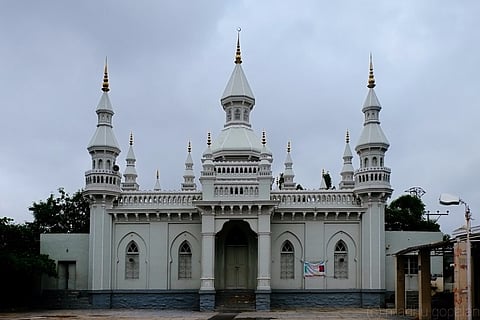

If you’ve been to the old airport in Hyderabad, chances are you’ve spotted the minarets of the Spanish Mosque, a rare example of Moorish architecture in the city. Moorish architecture is a kind of Islamic architecture that originated in the Iberian Peninsula, of which Spain is a part. With heavy Roman influences, the style is characterized by horseshoe arches, intricate calligraphy and mosaic work.
The Spanish Mosque was commissioned by the Paigah Nawab Viqar-ul-Umra Iqbal-ud-Doula after a trip to Spain, where he is said to have been very impressed by the architecture he saw. The mosque is also called Jama Masjid Iqbal-ud-Doula after him.
The Paigahs were an aristocratic family of the princely state of Hyderabad, founded by a soldier named Abul Fateh Khan Tegh Jung Bahadur. Appointed to protect the second Nizam of Hyderabad, he was given the hereditary title Paigah, because he commanded an army, called a Paigah. Paigah also means "right hand man", so it was no surprise that the Nizam called him that.
"Shams-ul-Umra" or "the sun among the nobles" was another of his titles. Sons of the Paigah family traditionally married princesses from the Nizam’s family, so they were the most powerful nobles in Hyderabad. They were passionate builders too, leaving their stamp on the city in the form of beautiful palaces and mansions.
The builder of the Spanish Mosque, Nawab Viqar-ul-Umra Iqbal-ud-Doula, was the maternal grandson of the third Nizam. Among his contributions to Hyderabad’s Paigah legacy are the Paigah Palace, Vikhar Manzil and the iconic Falaknuma Palace. He commissioned the Spanish Mosque in the year 1900. Sadly, he died within a couple of years, and its completion had to be overseen by his son.
The mosque stands on one end of a sprawling courtyard. What strikes the visitor first is that instead of the bulbous domes seen in other mosques, the roof and the minarets of this mosque end in slender octogonal spires plastered in lime.
Another unusual feature is the lack of an ablution tank. Inside the mosque, the prayer hall is decorated with beautiful Moorish arches and delicate calligraphy. The mosque is painted a pale mint green now, but until a few years ago, it was cream, with the roof and minarets glinting in gold.
Hyderabad has its share of magnificent mosques - the colossal Mecca Masjid that was completed about seven decades after its construction began, the sublime Toli Masjid, the huge Kulsumpura Masjid named after a princess, the Miya Mishk Masjid built by an Abyssinian guard in the Golconda army, the Hayathnagar mosque built by an inspirational royal lady, and so many more. While these are all special in their own ways, the most offbeat mosque in the city is undoubtedly the Spanish Mosque.
(All photographs by Madhumita Gopalan)
Madhumita Gopalan is a photographer, blogger and history enthusiast who loves photo-documenting travel, culture and architecture. She blogs at www.madhugopalan.com
Also read: